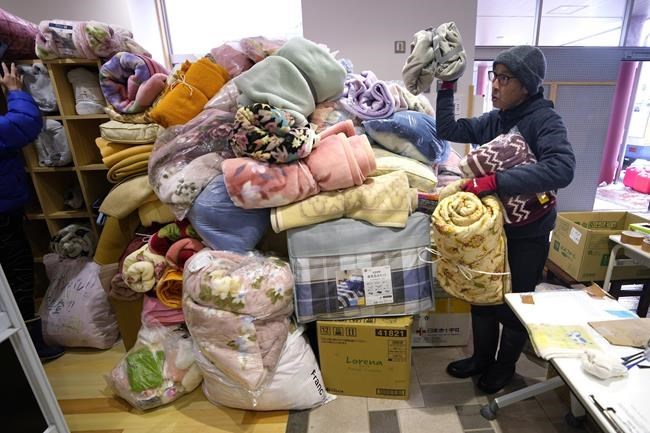
People bring extra blankets for evacuees at an evacuation center in Wajima in the Noto peninsula facing the Sea of Japan, northwest of Tokyo, Sunday, Jan. 7, 2024. Monday's temblor decimated houses, twisted and scarred roads and scattered boats like toys in the waters, and prompted tsunami warnings. (AP Photo/Hiro Komae)
Republished January 07, 2024 - 6:50 PM
Original Publication Date January 06, 2024 - 8:16 PM
WAJIMA, Japan (AP) — Rescue teams worked through snow to deliver supplies to isolated hamlets Monday, a week after a powerful earthquake hit western Japan, killing at least 161 people.
Heavy snowfall in Ishikawa Prefecture over the weekend and into the new week added to the urgency.
After the New Year's Day 7.6 magnitude temblor, 103 people were still unaccounted for, down from the more than 200 reported earlier, and 565 people were injured. Hundreds of aftershocks have followed, rattling Noto Peninsula, where the quakes were centered.
Taiyo Matsushita walked three hours through mud to reach a supermarket in Wajima city to buy food and other supplies for his family. The home where he lives with his wife and four children, and about 20 nearby homes, are among the more than a dozen communities cut off by landslides.
Power was out, and in a matter of hours, they couldn’t even use their cell phones, he told Jiji Press.
“We want everyone to know help isn’t coming to some places,” Matsushita was quoted as saying by Jiji Press. “We feel such an attachment to this community. But when I think about my children, it’s hard to imagine we can keep living here."
Late Saturday, a woman in her 90s was rescued from a crumbled home in Suzu, Ishikawa Prefecture, after 124 hours trapped in the rubble. She was welcomed by shouts of encouragement, although the darkness and a long blue sheet of plastic blocked her from view.
Chances for survival greatly diminish after the first 72 hours.
Of the deaths, 70 were in Wajima, 70 in Suzu, 11 in Anamizu and the rest in smaller numbers spread among four towns. Firefighters and other disaster officials were trying to get to nine people believed to be buried under collapsed houses in Anamizu, Japanese media reports said.
Ishikawa officials say 1,390 homes were destroyed or severely damaged. Many of the houses in that western coastal region of the main island are aging and wooden. Cars lay tossed on cracked, bumpy roads. Snow blanketed the debris and highways. Wires dangled from lopsided poles.
The nearly 30,000 people who evacuated to schools, auditoriums and community facilities slept on cold floors. They trembled in fear through the aftershocks. They prayed their missing loved ones were safe. Others cried softly for those who had died.
Mikihito Kokon, one of those who had evacuated, was worried about what the snowfall might do to his home, which was still standing but a wreck.
“You don’t even know where to start or where the entrance is,” he sighed.
Some people were living out of their cars, and long lines formed at gas stations. Food and water supplies were short. Worries grew about snow and rainfall, which raise the risk of mudslides and further damage, as snow collecting on roofs can flatten barely standing homes.
A fire that raged for hours gutted a major part of Wajima, and a tsunami swept through homes, sucking cars down into muddy waters.
“We're all doing our best to cope, helping each other, bringing things from home and sharing them with everyone,” Kokon said. "That is how we are living right now.”
___
Kageyama reported from Tokyo. She is on X: https://twitter.com/yurikageyama.
News from © The Associated Press, 2024